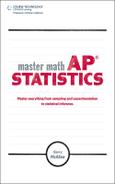The following are the assumptions and conditions essential for proper statistical inference. Be sure that you know and understand all of the assumptions and conditions for the various types of confidence intervals and tests. Make certain that you check them accordingly when conducting inference on the AP Exam. It will be assumed that you know that the assumptions and conditions should always be checked when doing inference. The test questions about inference will probably not remind you to check them.
Assumptions 1. Individuals are independent | Conditions 1. SRS and <10% of population (10n<N) |
2. Normal population assumption | 2. One of the following:
|
Remember that matched pairs are a one-sample t-procedure. Check the assumptions and conditions for a one-sample t-procedure when doing matched pairs. You should also be sure to state that the “data are matched,” as this is an added assumption.
|
1. Samples are independent of each other | Conditions 1. Are they? Does this seem reasonable? |
2. Individuals in each sample are independent | 2. Both SRSs and both <10% population (10n<N for both samples) |
3. Normal populations assumption | 3. One of the following:
|
Assumptions 1. Individuals are independent | Conditions 1. SRS and n < 10% of population |
2. Sample is large enough | 2. np ≥ 10 and n(1 − p) ≥ 10 Use |
Assumptions 1. Data are in counts | Conditions 1. Is this true? |
2. Data are independent | 2. SRS and <10% of population (10n<N) |
3. Sample is large enough | 3. All expected counts ≥ 5 |
Assumptions 1. Data are in counts | Conditions 1. Is this true? |
2. Data in each sample are independent | 2. SRSs and each sample <10% of population (10n<N) |
3. Samples are large enough | 3. All expected counts ≥ 5 |
Assumptions 1. Relationship has linear form | Conditions 1. Scatterplot is approximately linear |
2. Residuals are independent | 2. Residual plot does not have a definite pattern |
3. Variability of residuals is constant | 3. Residual plot has even spread |
4. Residuals are approximately normal | 4. Graph of residuals is approximately symmetrical and unimodal, or normal probability plot is approximately linear |
